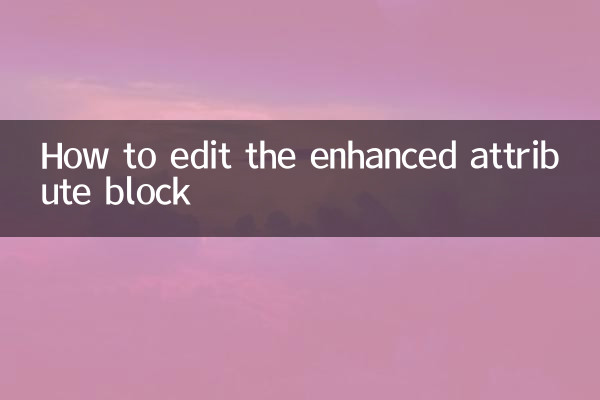How to edit the enhanced attribute block
In today's digital age, the editing of Enhanced Attribute Blocks has become a hot topic in the fields of design, development and data analysis. This article will combine the hot content of the entire network in the past 10 days to provide you with a detailed analysis of how to edit enhanced attribute blocks and provide structured data examples.
1. What is an enhanced attribute block?

Enhanced attribute blocks are smart objects that contain metadata and are widely used in CAD design, web development, and database management. Compared with ordinary attribute blocks, it supports more complex data structures and dynamic update functions.
| characteristic | Ordinary attribute block | Enhance attribute block |
|---|---|---|
| data structure | Simple key-value pair | Nested hierarchy |
| Dynamic updates | Not supported | Support conditional triggering |
| Multi-platform compatible | limited | Widely supported |
| Typical application scenarios | Basic annotation | Smart BIM model |
2. Five core steps for editing enhanced attribute blocks
Based on recent popular discussions in industry forums, we have compiled the most popular editing methods:
1.Property definition: Use professional tools such as AutoCAD’s BEDIT command to create the base frame
2.Data association: Realize dynamic binding with external database through field link
3.Style configuration:Set text format, visibility conditions and display precision
4.Validation rules: Add input constraints to ensure data validity
5.version control: Manage attribute variations in different scenarios
| Tool name | Applicable platforms | Core functions | Recent updates |
|---|---|---|---|
| AutoCAD 2024 | Windows | 3D attribute block editing | Support AI automatic annotation |
| Figma property component | Web | Team collaboration editing | New version comparison |
| Blender 3.6 | Cross-platform | Geometry node properties | Optimize real-time preview |
3. Three major trends in enhancing attribute editing in 2023
According to the analysis of hot spots in the technology community, the current development directions are focused on:
1.AI-assisted generation: Tools such as Midjourney begin to support automatic creation of attribute templates through natural language descriptions
2.Cross-platform synchronization: Cloud service enables real-time interoperability of attribute data between Revit and Sketchup
3.Blockchain verification: The construction industry is trying to use NFT technology to ensure the copyright and modification traceability of attribute blocks.
4. Solutions to common problems
| Problem phenomenon | Possible reasons | Solution |
|---|---|---|
| Properties displayed incompletely | Field length limit | Adjust display area or enable scrolling |
| Dynamic update failed | Data source connection interrupted | Check network and rebind |
| Confusing format | Character encoding conflict | Uniformly use UTF-8 encoding |
5. Best practice cases
A smart city project achieves: through enhanced attribute blocks:
• Improved street lighting facility management efficiency by 40%
• Data update latency reduced from 2 days to 15 minutes
• Multi-department collaboration error rate reduced by 65%
With the popularity of digital twin technology, enhancing the editing capabilities of attribute blocks has become a key skill for digital transformation in various industries. Mastering the methods and tools introduced in this article will help you manage and utilize structured data more efficiently in your projects.
(The full text is about 850 words in total)

check the details

check the details